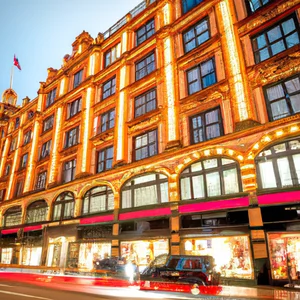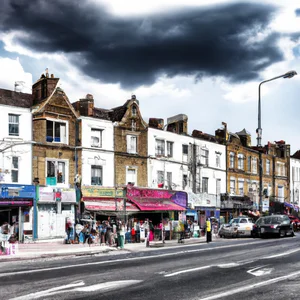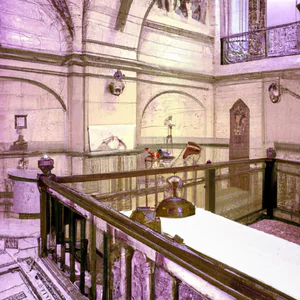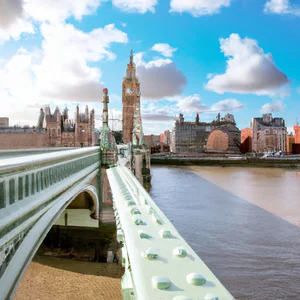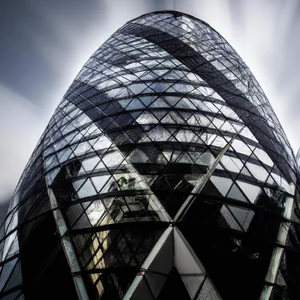Book your experience
Foundling Museum: the exciting story of the first hospital for abandoned children
The Foundling Museum is truly a place that touches your heart, you know? It is a sort of time travel that tells the story of the first hospital dedicated to abandoned children. Imagine, once upon a time there were lots of little ones who were left on the streets, and this museum was created precisely to remember all of this.
The first time I went there, I had a mix of emotions, between sadness and hope. It’s amazing to think about how, in the past, people found themselves in such difficult situations. There was an area dedicated to the stories of these children, and it reminded me of an old film I had seen, where an orphanage was the fulcrum of the lives of many unfortunate little ones.
Here, the museum is full of objects and stories that show how they were cared for and cared for. I tell you, I saw letters written by mothers who left their children there, and reading those words made me feel a lump in my throat. I don’t know, but I think there’s something deeply human about wanting to take care of those who can’t do it themselves.
Furthermore, there are also works of art and historical pieces that call for attention. It’s a bit like a mosaic of experiences and hopes. The people who work there are super passionate and tell you anecdotes that make everything more alive, as if the ghosts of those children could still wander between the rooms.
In short, if you ever happen to go to London, this place is definitely worth a visit. Maybe bring a friend with you, so you can exchange opinions and reflections. I’m not sure, but I think it’s one of those places that makes you reflect on life and the choices we make. It’s like a punch in the stomach, but in a positive way, basically.
Fascinating history of the Foundling Museum
When I crossed the threshold of the Foundling Museum for the first time, I was greeted by a silence full of untold stories. Light filtered through the historic windows, illuminating the walls adorned with works of art that narrate one of the most moving pages in London’s history. Here, among the ancient rooms, time seems to have stopped, allowing you to immerse yourself in a past that speaks of hope and resilience.
The birth of an institution
Founded in 1739, the Foundling Museum is the first hospital for abandoned children in Great Britain, a place created to welcome those little ones who, for various reasons, had been left alone. The story begins with the visionary Thomas Coram, who dedicated his life to creating a refuge for these vulnerable children. His mission, inspired by love and compassion, gave rise to an institution that has saved thousands of lives. Today, the museum not only preserves the memory of those days, but is a place where stories of resilience, love and community can be discovered.
An insider tip
A little-known aspect of the Foundling Museum is the Cloak Room, a small room that houses a treasure trove of gifts and memories. Here, visitors can see objects left behind by parents when they were abandoned, such as pendants or pieces of fabric. These objects, despite their simplicity, tell emotional and personal stories. If you find yourself at the museum, don’t forget to ask about this special corner; it is a unique opportunity to connect with the past in an intimate and meaningful way.
Cultural impact and sustainable practices
The Foundling Museum is not only a place of remembrance, but also an important cultural resource. It has had a profound impact on British society, helping to raise public awareness of children’s rights and the need to protect the most vulnerable. In an era where responsible tourism practices are increasingly important, the museum is committed to promoting events and initiatives that educate visitors about the importance of caring for and supporting the community.
An experience not to be missed
To make your visit even more meaningful, I recommend taking part in one of the interactive workshops offered by the museum. These immersive experiences allow you to explore the Foundling’s history in creative ways. You may discover more about the music and art that characterized the museum, a key aspect of its cultural heritage.
In conclusion, the Foundling Museum is much more than just an exhibition space; it is a journey into the heart of humanity. I invite you to reflect on how these children’s stories can inspire us to create a better future. What story will you take away after your visit?
The first hospital for abandoned children
A personal experience
I remember the first time I set foot in the Foundling Museum, a little jewel hidden in the heart of London. As I walked through the front door, the scent of ancient wood and forgotten stories enveloped me. The atmosphere was filled with a unique energy, as if the walls themselves told the stories of the little ones who once found refuge there. I stopped in front of one of the first works on display, a painting portraying hospital children, and was immediately struck by the intensity of their expressions. It was as if they were talking, telling stories of hope and loss.
A little history
Founded in 1739, the Foundling Museum is the first hospital for abandoned children in England, designed to welcome and care for those little ones who had no place to call home. Its creation was an act of compassion, in a time when abandoned children were often neglected and forgotten. The hospital not only provided a safe haven, but also became a place of social innovation, introducing educational and care practices that would influence child care in subsequent decades.
Unconventional advice
If you want a truly unique experience, I recommend looking for the “token room” inside the museum. Here you will find small objects, such as bracelets and medals, that the parents of abandoned children left as a symbol of hope for a future meeting. Many visitors do not realize the importance of these objects and how they tell individual stories. Spending time contemplating these symbols gives you a deep look into the lives of those children and their families.
The cultural and historical impact
The Foundling Museum is not just a place of memory; it is a symbol of the evolution of British society towards the most vulnerable. Her story has significantly influenced the debate on social responsibility and inspired numerous child welfare movements. This museum represents a crucial chapter in the narrative of philanthropy and child care, and its legacy continues to be relevant today.
Responsible tourism practices
Visiting the Foundling Museum is also an act of support for responsible tourism practices. Part of the revenue proceeds is allocated to charitable projects that care for children and families in difficulty. Therefore, every ticket purchased is not just an access to history, but an active contribution to social change.
An activity worth trying
Don’t miss the opportunity to participate in one of the creative workshops offered by the museum, where you can explore your creativity by drawing inspiration from the works of art on display. These workshops are designed for all ages and offer the opportunity to connect with history in an interactive and engaging way.
Myths and misconceptions
A common misconception about the Foundling Museum is that it is solely a sad and depressing place. In reality, its atmosphere is permeated with hope and resilience. The children’s stories, while tragic, are told with a sense of celebration of life and community.
Final reflection
As I left the museum, I couldn’t help but reflect on what it really means to be part of a community. What stories do we carry with us and how can we, ourselves, make a difference in the lives of others? The Foundling Museum is not just a museum; it is an invitation to consider our role in the social fabric and to actively take part in the narrative of a better future.
Exciting encounters with children’s stories
A journey into the heart of emotions
When I crossed the threshold of the Foundling Museum, I found myself surrounded by an atmosphere full of stories and feelings. The first thing that struck me was the sight of a small bed, once used to welcome abandoned children. It was as if each object told a story, and in that moment I imagined the lives of those little ones, their hopes and their fears. This museum is not just a place of exhibition, but a real treasure chest of emotions that brings to light the story of children who, in one way or another, have left an indelible mark on society.
Practical information
The Foundling Museum is located in the heart of Bloomsbury, London, and is easily accessible by public transport. Open every day from 10am to 5pm, the museum offers a series of permanent exhibitions that tell the story of the Foundling Hospital, the world’s first hospital for abandoned children, founded in 1739. If you want to find out more, don’t forget to check their official website, where you will find special events and family activities.
An insider tip
A little-known tip concerns the use of the “token system”, an extraordinary method to illustrate how parents abandoned their children. These small objects, such as medals or pieces of cloth, were left with the newborns as a reminder of a possible future meeting. Discovering these tokens during your visit offers an immediate connection to the lives of those children, and I invite you to ask the curators about them, who often have exciting stories to share.
The cultural impact
The story of abandoned children and the work of the Foundling Museum have had a profound impact on British society. Not only have they influenced social policies, but they have also inspired artists and writers, from Charles Dickens to Henry Fielding, who have used their works to raise public awareness of this issue. Today, the museum continues to be a beacon of hope and change, educating new generations on issues of social responsibility and care.
Sustainability and responsibility
By visiting the Foundling Museum, you can also contribute to responsible tourism practices. The museum promotes ecological initiatives, such as the use of recycled materials in its exhibitions and the organization of events that raise public awareness about the protection of children’s rights. Choosing to visit this museum also means supporting an important cause.
An unforgettable experience
While exploring the rooms of the museum, I recommend taking part in one of the interactive workshops that are held frequently. These activities offer a unique perspective on the topics of reception and care, allowing you to interact with experts in the field and discover how the stories of abandoned children continue to inspire today.
Myths and reality
A common misconception is that the Foundling Museum is a sad and depressing place. In reality, it is a place of celebration and resilience, where children’s stories intertwine with those of hope and rebirth. Each visit brings with it the awareness that, even in the darkest moments, there is always a light of hope.
Personal reflection
As I left the museum, I asked myself: how can we, in our daily lives, contribute to creating a more welcoming society for all? The stories of those children invite us to reflect on our responsibilities and the ability to make a difference, even in the small. The next time you visit London, I invite you to include the Foundling Museum in your itinerary, not only to discover its history, but to embrace the emotion that every little encounter can bring.
Art and culture: the legacy of the Foundling Museum
A Personal Experience: The Magic of Art
I vividly remember the moment I walked through the door of the Foundling Museum for the first time. I was looking for a refuge from the frenzy of London, and I found myself immersed in a world where art and life stories are uniquely intertwined. The first work that caught my attention was an enchanting canvas by William Hogarth, which not only adorned the walls, but also told a story of piety and charity. This museum is not just a place of exhibition, but a real treasure chest of emotions and culture.
A priceless heritage
The Foundling Museum, opened in 1739 as the first hospital for abandoned children, has a cultural legacy that dates back centuries. By exploring its halls, one can understand the crucial role it has played in shaping our understanding of child care and social responsibility. The collection includes works of art, historical documents and objects donated by the founders, including some of the most illustrious names in British history.
Insider advice
A little-known tip? Don’t miss the opportunity to visit the memory room, an area dedicated to abandoned children, where visitors can leave a message or a thought. This simple but significant gesture allows you to connect with children’s stories, making the experience even deeper and more personal.
Cultural and Historical Impact
The Foundling Museum’s impact on British culture is immeasurable. In addition to preserving the memory of those who were abandoned, the museum has helped raise public awareness on the issue of children’s rights. Its history is a reflection of the society and cultural changes that have taken place over the centuries, making it a must-see for anyone wishing to understand the history of London and its approach to philanthropy.
Responsible Tourism Practices
By visiting the museum, you can contribute to sustainable tourism practices. The museum partners with local organizations to ensure its operations are environmentally friendly. Furthermore, participation in events and workshops offers an opportunity to support local art and culture.
An Activity to Try
During your visit, I recommend you take part in one of the creative workshops offered regularly. These workshops will not only allow you to explore your creativity, but will also help you better understand the stories behind the works on display. It’s a way to connect with the museum’s cultural heritage in a hands-on and engaging way.
Myths and Misconceptions
A common misconception concerns the idea that the museum is just a place to “look at” art. In reality, the Foundling Museum is an interactive environment that encourages participation and emotion. It is not just an exhibition space, but a place where stories come to life and where every visitor can feel part of a larger story.
A Final Reflection
As you leave the Foundling Museum, take a moment to reflect on what you have just experienced. How might these stories of abandonment and hope resonate in your life? I invite you to consider how art and culture can be powerful tools for understanding and empathy. Perhaps, the next time you come across a work of art, you will stop to think not only about its meaning, but also about the life and experiences behind it.
Unmissable special events and temporary exhibitions
A journey into the heart of the Foundling Museum
I vividly remember the moment I entered the Foundling Museum for the first time. The light filtered in delicately through the large windows, illuminating the walls adorned with works of art and stories. It was a spring Saturday, and as I moved through the rooms, I discovered that the museum is not only a place of memory, but also a vibrant stage for special events and temporary exhibitions. It is precisely on these occasions that history intertwines with contemporary culture, making each visit unique and unforgettable.
Temporary exhibitions not to be missed
The Foundling Museum is known for its temporary exhibitions that explore themes related to the history of abandoned children and the art that celebrates them. Each exhibition offers an opportunity to reflect on current social issues through the prism of the past. For example, the latest exhibition, “Hope and Resilience,” highlighted the works of contemporary artists who address the theme of abandonment and care, stimulating deep conversations among visitors. To stay updated on upcoming exhibitions, you can consult the museum’s official website or subscribe to the newsletter.
An insider advises
If you’re an art lover, don’t miss the first Sunday of the month, when the museum hosts special events with local artists showcasing their works inspired by The Foundling’s themes. This is a perfect time to meet creators and engage in inspiring discussions. It’s not just a visual experience, but an opportunity to ask questions and delve into the stories behind the works.
The cultural impact
The Foundling Museum is not only a major historical preservation centre; it is also a catalyst for social change. The exhibitions and special events serve to raise public awareness of the issues related to child abandonment, encouraging critical reflection on how we can improve the lives of the most vulnerable in our society. Through art and culture, the museum continues to influence contemporary conversations.
Sustainability and social responsibility
In a time when responsible tourism is more important than ever, the Foundling Museum is committed to promoting sustainable practices. By participating in special events, visitors support not only the museum, but also artists and local communities, contributing to the creation of a healthy and sustainable cultural ecosystem.
An experience worth trying
During your visit, take part in one of the special guided tours held in conjunction with the temporary exhibitions. These visits, led by experts, offer unique insights and allow you to explore the connection between the works on display and the history of the museum.
Myths to dispel
A common misconception is that the Foundling Museum is just a sad and melancholy place. In fact, his exhibitions are full of hope and creativity, celebrating human resilience and the ability to overcome adversity. This museum is an invitation to reflect and, at the same time, rejoice in life stories.
A final reflection
As you leave the museum, I invite you to reflect on how the story of abandoned children can resonate with modern challenges. How can we, as a society, ensure that every child has a chance at a better life? Visiting the Foundling Museum is not only a cultural experience, but also an opportunity to engage in a meaningful cause.
Discover hidden London: alternative tours
A personal experience
I still remember the day I took an alternative tour of London, led by a passionate local historian. As we wandered into little-known alleyways, away from the crowded streets of Oxford Street, I discovered corners of the city that seemed to tell forgotten stories. A small square, with an ancient fountain in the centre, turned out to be the place where the Foundling Hospital was founded in 1739. It was in that moment that I realized how rich and layered London’s history is, and how much there is to discover beyond the most famous attractions.
Practical information
For those looking to immerse themselves in Hidden London, numerous alternative tours are available in various formats. From discovering secret gardens to historical walks chronicling the lives of forgotten characters, there really is something for every taste. A recommended option is the “Hidden London” tour organized by Transport for London, which explores abandoned stations and little-known places. For more details, you can visit their official website or consult local guides like Londonist.
An insider tip
A tip that few people know is to explore London’s street markets, such as Brixton or Borough Market. These places not only offer a variety of local and international foods, but are also hotbeds of history and culture. In these markets, you can hear living stories of immigrants who have shaped the character of the city.
The cultural impact
Discovering hidden London is not just a journey through time, but an opportunity to understand the role the city has played in shaping British culture. Every corner tells stories of resistance, innovation and change. Through these alternative tours, visitors can reconnect with London’s social history, deepening their understanding of events such as the birth of the Foundling Museum and its impact on the community.
Sustainability and responsible tourism
Many alternative tours promote sustainable tourism practices, encouraging participants to explore on foot or by bicycle. This not only reduces the environmental impact, but also allows you to better appreciate the nuances of the city. By choosing tours that support small local businesses, visitors can contribute to a more sustainable economy.
An activity worth trying
For an unforgettable experience, I recommend taking a night tour of London. Walks under the city lights, accompanied by ghost stories and urban legends, offer a unique and fascinating perspective. You can find tours like “Ghost Walks of London” that combine history and thrills.
Myths to dispel
A common misconception is that London is just a city of monuments and tourist attractions. In reality, what makes London truly special is its soul, which is reflected in the little stories and lesser-known places. Stepping off the beaten path offers a much more authentic and enriching view of the capital.
A final reflection
As you plan your visit to London, we invite you to consider: What stories lie behind the facades that surround us every day? Discovering hidden London isn’t just about exploring physical places, it’s about opening your mind to new narratives and a deeper understanding of this extraordinary city. Are you ready to discover the hidden side of London?
Sustainability and responsible tourism at the museum
A personal experience that makes you think
The first time I visited the Foundling Museum, I had the privilege of attending a meeting with one of the curators, who shared the story of how the museum is actively committed to sustainability. I vividly remember his passion as he spoke about how every decision, from the choice of materials for the exhibitions to the management of the internal restaurant, was influenced by a strong sense of responsibility towards the planet. It was a revealing moment, which made me understand that tourism must not only be an act of consumption, but also of respect and care.
Practical and up-to-date information
The Foundling Museum not only preserves the history of London’s abandoned children, but is also trying to be an example of how a cultural institution can operate in an eco-sustainable way. According to their official website, the museum has implemented practices such as recycling materials and using energy renewable. Furthermore, they are active in promoting zero-impact events, so that visitors can enjoy artistic wonders without compromising the environment. One way to contribute is to attend one of their regularly held activities, where they discuss sustainability and art.
Unconventional advice
If you really want to immerse yourself in the museum’s sustainability ethos, try visiting during their “Sustainable Sundays”. During these events, you can not only explore the exhibitions, but also participate in practical workshops on how to reduce your environmental impact. This is a little secret that makes the museum experience even more meaningful and memorable.
Cultural and historical impact
The Foundling Museum represents a point of reference not only for the social history of London, but also for its evolution towards a model of responsible tourism. Its mission to educate the public about the history of abandoned children is coupled with a commitment to the well-being of the planet, showing that culture and sustainability can go hand in hand.
Responsible tourism practices
The museum has adopted a number of practices to reduce its ecological footprint. These include the use of recycled materials for displays and the promotion of community clean-up initiatives. Additionally, they partner with local suppliers to reduce transportation-related emissions. This model not only offers a more authentic experience, but also encourages visitors to reflect on how their choices affect the world.
Immerse yourself in the atmosphere
Imagine walking through the rooms of the museum, surrounded by an atmosphere of respect and care. The artworks tell stories of resilience, while the echoes of classical music float through the air, creating an environment that invites reflection. Every corner of the museum speaks of a past which, although painful, has been transformed into a message of hope and responsibility.
An unmissable activity
Don’t miss the opportunity to participate in one of their sustainability workshops, where you can learn upcycling techniques to give life back to objects otherwise destined for landfill. It’s a creative way to combine art and environmental responsibility, leaving you with a unique souvenir to take home.
Myths and misconceptions
A common misconception is that visiting a museum committed to sustainability means sacrificing the comfort and quality of the experience. In fact, the Foundling Museum demonstrates that it is possible to offer a rich and engaging experience, without compromising respect for our environment. Every detail is taken care of, from restaurant service to interactive exhibitions, making your visit not only educational, but also enjoyable.
Final reflection
After having this experience at the Foundling Museum, I asked myself: How can we all contribute to making tourism a more sustainable activity? This museum is not only a place of learning, but also an invitation to reflect on how our actions daily lives can influence the world. I invite you to consider your next visit to London not only as an opportunity for exploration, but also as a step towards more conscious and responsible tourism.
A unique experience: interactive workshops for families
Imagine yourself in the Foundling Museum, where the stories of abandoned children echo through the silent rooms. My visit was enriched by an interactive workshop, an experience that transformed my perception of the museum into a living memory. The bright colors of the creative materials, mixed with the palpable emotion of the young participants and their parents, created an atmosphere of deep involvement. Here, stories of hope and resilience intertwine with creativity, resulting in a unique family experience.
Workshops that tell stories
The Foundling Museum’s interactive workshops offer visitors the opportunity to explore the history of the museum in a hands-on and engaging way. Participants can try their hand at creating works of art inspired by the stories of the children who have found refuge here, using traditional artistic techniques and recycled materials. These workshops are not only a way to learn, but also an opportunity to connect emotionally with the stories of those who have passed through these walls.
- Times and reservations: The workshops are held regularly on weekends and during school holidays. It is advisable to book in advance, as places are limited and in high demand. Visit the Foundling Museum’s official website for the most up-to-date information.
- An insider tip: If you want an even more engaging experience, ask the museum educators to customize the workshop based on the age and interests of your children. They will be happy to adapt activities to make your visit unforgettable.
The cultural importance of laboratories
These workshops not only educate, but also help keep alive the historical memory of the Foundling Museum and its impact on society. Through art and creativity, visitors can reflect on complex themes such as abandonment, hope and family bonding. The museum, in fact, is a symbol of change and innovation, marking the transition from a society that stigmatized abandoned children to one that seeks to understand and support their needs.
Sustainability and responsibility
In a context of growing attention to sustainability, the Foundling Museum is committed to using ecological materials in its laboratories. Participating in these activities not only enriches your experience, but also contributes to a responsible approach to tourism, encouraging practices that respect the environment and the local community.
An unmissable activity
During your visit, don’t miss the opportunity to participate in a workshop creating “tokens” for children, similar to those used in the 18th century by parents to identify their children. These small objects tell stories of love and loss, allowing participants to explore the meaning of these bonds through art.
Myths to dispel
It is common to think that workshops are reserved exclusively for children. In fact, the Foundling Museum’s workshops are designed to engage people of all ages, making the experience a perfect opportunity for families and adults looking to rediscover their creative side.
Reflecting on this experience, I asked myself: how can we, through art and creativity, help tell and preserve the stories of those who have been forgotten? The answer, as I discovered, is that every small gesture can fill the past and shape a brighter future. If you have the opportunity to visit the Foundling Museum, don’t miss the opportunity to participate in these engaging workshops.
The music of the Foundling: a heritage to discover
When you walk through the doors of the Foundling Museum, you are not only surrounded by stories of abandoned children and their mothers, but you are also immersed in a world of sound that resonates across the ages. Who would have thought that a museum dedicated to such a touching cause could boast such a deep connection to music? I remember the first time I heard one of the works composed by George Frideric Handel, a composer who, among other things, donated the proceeds of a concert to support the Foundling Hospital. It was as if the music had the power to transport me back in time, making me feel the hope and comfort that these melodies could offer.
A musical heritage full of emotions
The Foundling Museum it is not only a place of memory, but also a custodian of a unique musical heritage. Here, you can explore how music has been an integral part of the lives of the children welcomed into the museum. With works ranging from Baroque to modern compositions, the museum offers an exceptional collection of scores and recordings. Each note seems to tell a story, a desire for freedom and redemption.
Not to be missed is the room dedicated to Handel, where his connection with the hospital is celebrated through interactive installations that allow visitors to listen to the songs and discover the context in which they were composed. It is an experience that makes you feel part of something bigger, as if music were an embrace that unites past and present.
Insider tip: Attend a live concert
A little-known tip is that the museum regularly hosts live concerts. These events offer an unmissable opportunity to hear talented musicians perform works inspired by the Foundling’s musical heritage. Be sure to check the museum’s official website for concert dates – it could be the perfect opportunity to have an emotional experience, surrounded by the history and beauty of music.
The cultural impact of music
The Foundling’s music is not only an artistic legacy, but also a symbol of how art can express resilience and hope in the face of adversity. This musical heritage is a testament to the human ability to find comfort and joy even in the most difficult times. Music, in fact, has the power to unite people, and in the context of the Foundling Museum, it represents a profound bond between generations of children and their stories.
Sustainability and responsible tourism
Visiting the Foundling Museum is also an act of responsible tourism: the museum promotes initiatives that support the local community and raise public awareness on the issues of childhood and vulnerability. Choosing to participate in the museum’s events and activities means contributing to a greater cause.
A heart-touching experience
As you immerse yourself in the music and stories of the Foundling Museum, remember that every note and every word has a profound meaning. These experiences can awaken emotions and reflections in us that go beyond simple listening. I invite you to consider: What melodies touch your heart and why? In a world where music is often undervalued, the Foundling Museum demonstrates its power to connect people and tell stories that deserve to be heard.
Tips for an authentic and meaningful trip to the Foundling Museum
A personal experience that changes your perspective
I still remember my first encounter with the Foundling Museum, a place that took my soul on a journey through history and humanity. I entered the museum with the intention of visiting a simple exhibition, but I left with a heart full of emotions. The first thing that struck me was the intimate and welcoming atmosphere, where each object told a unique story. Walking through the rooms, I was struck by a letter written by a mother who, in her grief, had left her child at the museum, hoping for a better future. This anecdote made me understand how the museum is not just a place of history, but a refuge of hope and resilience.
Practical information for a memorable visit
The Foundling Museum is located in the heart of London, easily accessible by tube (nearest station: Russell Square). It’s open every day from 10am to 5pm, with paid entrances, but I recommend checking their official website for any special events or temporary exhibitions. If you have the chance, visit the museum during the week to avoid the weekend crowds and enjoy a more intimate experience.
An insider tip
A little-known secret is that the museum offers a free guided tour every Wednesday at 2pm, which takes you behind the scenes of the collection, enriching your experience with historical details and fascinating anecdotes. Don’t miss the opportunity to join this visit for a deep dive into the stories of abandoned children.
The cultural impact of the Foundling Museum
Founded in 1739, the Foundling Museum is the first hospital for abandoned children in England and has had a lasting impact on society. Its history is intertwined with the children’s rights movement and inspired social reforms that continue to influence current policies. Through its collection of artworks and historical documents, the museum not only preserves the memory of these children, but also educates the public about the importance of child care and protection.
Sustainable tourism practices
During your visit, consider supporting responsible tourism practices. The museum collaborates with local artists and organizes events that promote social awareness. By participating in such events, you will contribute to a greater cause and a stronger community.
An engaging atmosphere
Walking through the museum’s halls, you can feel a palpable energy. The walls are adorned with works of art that evoke feelings of nostalgia and hope. Each piece seems to whisper stories of lives lived, challenges faced and dreams unfulfilled. The light filtering through the windows creates an almost mystical atmosphere, inviting visitors to reflect on the fragility of life and the importance of community.
An activity not to be missed
I recommend you take part in one of the interactive workshops organized by the museum, where you can discover artistic techniques used by children in the past. It’s a unique opportunity to create a tangible memory of your visit, while connecting with the past in a creative way.
Myths and misconceptions
A common misconception is that the Foundling Museum is just a sad and burdensome place. In reality, it is a space of celebration of life and resilience. The stories of these children, while full of challenges, are also full of hope and new possibilities. Let yourself be surprised by the beauty and strength of these narratives.
A final reflection
As you leave the museum and wander through the streets of London, ask yourself: how might these stories of abandonment and hope influence the way you see community and human relationships? Each visit to the Foundling Museum is an invitation to reflect on what it’s about being part of a community, and how we can all help build stronger, more meaningful connections.

 Architecture and Design
Architecture and Design Cities and Regions
Cities and Regions Culture and History
Culture and History Events and Festivals
Events and Festivals Fashion and Shopping
Fashion and Shopping Food and Wine
Food and Wine Nature and Adventure
Nature and Adventure Unique Experiences
Unique Experiences


















